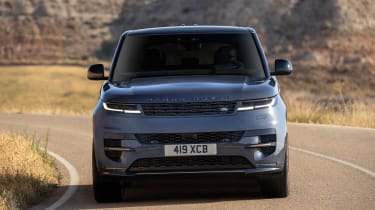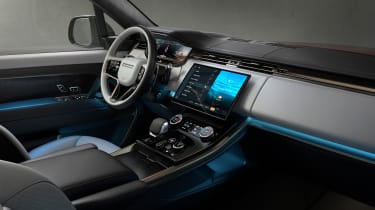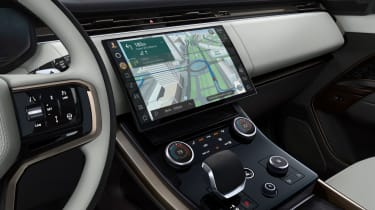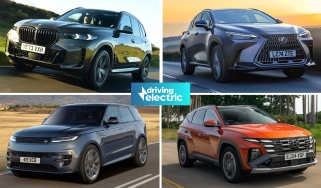Range Rover Sport PHEV review
The Range Rover Sport PHEV features a pure-electric range of 75 miles and a luxurious cabin

Pros
- Long electric range and fast charging
- Surprisingly agile
- Luxurious and practical
Cons
- Cheap-looking speaker surrounds
- 2.7-tonne weight
- Costlier than before
| Car type | Electric range | Fuel economy | CO2 emissions |
|---|---|---|---|
| Plug-in hybrid | 75-76 miles | 367-471mpg | 15-18g/km |
Like the fifth-generation of the full-fat Range Rover, the Range Rover Sport will be available as an all-electric car by 2024. Until then, it’s offered with a thoroughly reworked pair of plug-in hybrid (PHEV) powertrains to go with the new car's cleaner, simpler design and state-of-the-art interior.
There are now two PHEVs to choose from and the big news is that they can travel significantly farther on electric power than before. While the old model could cover just 25 miles in electric mode, the new Range Rover Sport PHEV can achieve 75-76 miles, according to Land Rover figures. In reality, that’s likely to mean roughly 60 miles – still an impressive figure for such a large SUV.
Both versions – the 453bhp P460e and the 542bhp P550e – feature a relatively huge 38.2kWh battery, so it’s still a little hard to praise the car for its efficiency. After all, the old 39kWh Hyundai Kona Electric managed 189 miles of range without a petrol engine to fall back on.
But the larger battery does make the Range Rover Sport PHEV more versatile than before. Daily commutes or significant portions of motorway journeys can be done without troubling the 3.0-litre six-cylinder petrol engine. Use the car as intended, and remember to charge the battery overnight, and you may achieve 471mpg in the P460e or 456mpg in the P550e, so the plug-in hybrid Range Rover Sport should be the most affordable version to run.
If you’re having one as a company car, which is likely to be the case for a significant number of buyers, then the Range Rover Sport PHEV does well for company-car tax. Even the top model returns 18g/km on the WLTP cycle, resulting in an 5% Benefit-in-Kind (BiK) tax bill, saving you thousands of pounds in tax compared to the mild-hybrid or the V8 petrol variants.
The plug-in models are some of the more expensive in the line-up though, with prices starting at £93,000 for a Dynamic SE model and quickly rising to over £114,000 for a range-topping Autobiography – and that’s before you add any extras from the options and accessories catalogue. It’s perhaps a necessary evil from the bigger battery and all the technology on board, but it still makes the Range Rover Sport PHEV considerably dearer than the Volvo XC90 Recharge or Porsche Cayenne E-Hybrid.
Whether you go for the P460e or the P550e, you get a 139bhp electric motor mated to a 3.0-litre turbocharged six-cylinder petrol engine. Our test car was the more potent P550e, which produces a combined 542bhp and a whopping 550Nm of torque, available throughout the rev range from just 1,000rpm. That huge wave of torque makes the Sport feel surprisingly urgent when you put your foot down, be it in town or on faster roads.
The official 0-62mph time is 4.9 seconds, but acceleration is smooth and sustained rather than lairy. It is a luxury SUV after all, and the Sport element does play second fiddle. That’s why the noise from the petrol engine is often quiet, although we’d like to hear a little more from it as it produces a lovely sound at high revs. The e-motor takes the reins for lower-speed acceleration, while the petrol engine kicks in once it reaches its stride.
It’s more dynamic than the full-size Range Rover PHEV, albeit not quite as good to drive as a Porsche Cayenne. Dynamic mode firms up the suspension to negate body roll and improve the feeling of control, without making the ride uncomfortable. The Range Rover Sport has lots of help in this department, with air suspension, active anti-roll control and a rear differential with torque distribution all fitted.
Four-wheel steering aids agility and is a real plus for city driving. The rear wheels turn by up to 7.3 degrees – in the opposite direction to the fronts at low speeds – which makes the large Range Rover Sport surprisingly easy to park, and to pilot around a tight multi-storey car park. It’s only at higher speeds that you’re reminded of the car’s size, as it’s hesitant to perform rapid direction changes.
Gear changes are generally smooth and seamless, but we’d like them to be a little snappier in the sportier driving modes. They’re a little sluggish when you use the paddles on the steering wheel to change gears yourself, but many owners will probably never do that, instead just leaving the gearbox to its own devices.
What is impressive is the way the car juggles its two power sources. It’s good at choosing when is appropriate for the petrol engine, the electric motor or a combination of both. Helpfully, the car uses sat nav data to work out how much electric power to save for later. Hybrid mode is the default setting, with an EV-only setting that makes sure you’re running on electric power for as long as possible. The Save mode holds back the battery power for later use, for example if you’re heading into a city.
When the battery needs topping up, it’s good to know that the Sport features fast-charging – unlike many PHEVs. An 80% recharge can be completed in as little as 40 minutes and a home wallbox will fully recharge the battery in around five hours. A three-pin domestic plug will take more than twice as long as that.
Just as the powertrains are shared with the bigger Range Rover, so are many interior parts. The dashboard, with its sweeping structure, 13.7-inch digital instrument cluster and 13.1-inch touchscreen, is carried over, but there’s a slightly cosier feel. Don’t mistake that for cramped; the Sport is still pretty spacious.
Some innovative materials lift the interior and the quality is superb. It certainly doesn’t feel like the product of a company which is tarnished with a poor reputation for build quality – although the sheer amount of technology on board may leave you with worries about dependability. Our only real criticism of the interior is the plastic stereo speaker pods on the doors, which feel cheap.
Our test car was the flagship Autobiography edition, which comes fully packed with equipment. The usual phone connectivity is joined by Alexa voice recognition and Spotify access, while the front seats offer heating, ventilation and massaging. Being a Land Rover, there’s also the firm’s latest off-road assistance tech in the form of cameras and Terrain Response.
A panoramic sunroof is fitted, and we’re glad to report that there’s still plenty of headroom beneath it. There’s more than enough legroom, and the boot is large (if not absolutely class-leading) at 647 litres. A few neat storage cubbies inside the cabin show that a lot of thought has gone into how customers will use the car and what will make daily life better.
There’s no getting away from the higher price tag of the new Range Rover Sport, but we came away from our time in it feeling that there’s little reason to stretch to the full-size Range Rover. Incidentally, the proper Range Rover starts at over £138,500 for an equivalent specification to our test car, and we’re not convinced that it feels almost £25k more luxurious.









